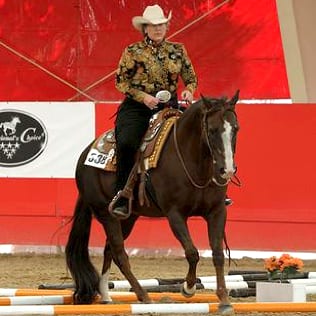Try it, You’ll Like it!
Now that AQHA Leveling and the new Novice Rules are in place, you may find yourself in a position to try a new class or two. After all, learning new things can be fun and exciting, right? However, if you find yourself feeling like a dog stuck with the same old tricks, these tips will help straighten out your learning curve and have you loving your new event in no time.
1. Natural law of Progress
For some reason, we think that progress occurs in a straight upwardly trending line, when in fact it is more like a foxtrot, with two steps forward and one step back. Instead of trying to change reality, learn to accept it. That way, when you are on the back step you will know that forward progress is right around the corner.
2. Break it down
Before embarking on your journey to mastering a new event you will need a road map to get you to your destination. Make a list of all of the acceptable maneuvers for your event and then rate your current ability from 1 – 10 for each one. Then ask yourself, “What would it take to get me to a 10?” You have now identified your key improvement area. But you aren’t done yet. Go ahead and seal the deal by committing to a target date for getting there. Your list may look something like this: Armed with factual data, you can prioritize and work on things that you do well while you tackle the more challenging elements that you still have to master. That way, your confidence and sanity will be with you during this process, which makes things much easier in the long run.
Horsemanship
| Manuever | Current Ability | Get to a 10 | By When? |
| Walk | 8 | crisper | 27-Feb |
| Jog | 8 | more collection | 15-Feb |
| Trot | 7 | body position | 10-Mar |
| Extended Trot | 7 | body position | 10-Mar |
| Lope | 9 | Straight transition | 15-Feb |
| Extended Lope | 7 | Faster! | 27-Feb |
| Simple Lead Change | 6 | One trot step | 10-Feb |
| Lead Change | 9 | Timing | 10-Mar |
| Lope on Straight Line | 8 | Focus on Target | 10-Feb |
| Lope in Circle | 6 | Even Circles | 12-Mar |
| 1/4 Turn | 7 | No Overturns | 12-Mar |
3. Have a Confidence Sandwich
One of the ways to preserve your confidence is to have some every
day, in the form of a sandwich. This is not something you can get at
Subway as a 6’” on whole wheat, hold the mayo, it is something you will
create when you are practicing. Think of the events that you are already
confident and competitive in as the bread, and the things that you want
to learn as the meat. Unless you are on some sort of carbohydrate
restricted diet, most people enjoy their sandwiches when they are made
with two pieces of bread, with the meaty stuff in the middle, and this
is how you will structure your training sessions. Spend the first third
of your session doing things you do well, then move on to your new event
for the next third, starting and ending with things that you do well
based on your chart. Then end with last third of your time in familiar
territory. Trust me, your horse, trainer and family members will be
grateful when you leave each session feeling good, full and satisfied.
4. Be Patient
When you are good at something, you are Unconsciously Competent,
meaning you don’t have to think about doing something well, it happens
automatically. On the flip-side, when you are learning new things, you
are entering the land of Conscious Incompetence, where you are well
aware of what you are not doing correctly. You may feel slow and clunky
as you begin to learn how to do something new. Just know that with
practice, you will build new associations in your brain, and before
long, your new skills will become automatic as well.
5. Step-By-Step
When you decide to make your official show ring debut in your new
class, just pick one thing that you would like to accomplish during your
class. It may be to remember your trail pattern, or nail all of your
markers. By choosing one performance goal that would mean you were
successful in the class, you won’t be bogged down with trying
to remember every little nuance that it takes to win. I encourage you to
create your own “Maneuvers Chart” similar to the one above. As you
progress, you can revisit your chart and keep it updated. There are
always things to learn and improve on, but by taking it one step at a
time, you won’t be biting off more than you can chew.
6. Lighten Up
When learning something new, don’t take yourself so seriously. Stuff
happens, and instead of getting mad and frustrated, you may find
something that you can laugh about. Keep it fun and light, and before
you know it, you will be looking for another class to master.









